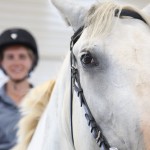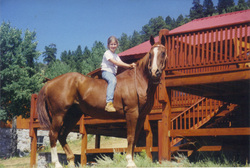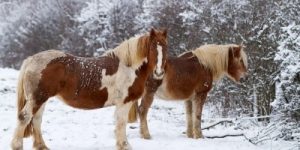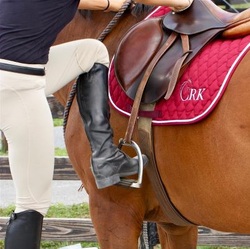Most of us don’t have as much time as we’d like to practice our riding. It can be frustrating to return to a lesson week after week and feel as though you don’t make much progress. Or to have an accident and be facing weeks of no riding time as you heal.
Today I’ve got a simple idea for you to help improve your riding even when you’re not in the saddle. This isn’t a new technique and I’m sure you’ve heard of it before, but I was doing a bit of research on this topic and found a few very interesting studies to prove its effectiveness. So what “practice-replacement technique” am I talking about? Visualization.
Visualization, or picturing yourself doing something, has become increasingly popular in the worlds of sports and performance, and for good reason – what we picture in our minds affects how we move our bodies.
In this week’s video, I’d like to share several studies that show how mental practice can be almost effective as real physical practice, how simple visualization can trigger real change in the body, and why how you visualize may also be important…
Now I’d love to hear from you – What are your experiences with visualization? When have you used it and did it help?
See you in the comments!
Callie
To read the studies referenced here, visit these links:
https://www.llewellyn.com/encyclopedia/print.php?id=244














31 Responses
I am going to try the visualization internally. It sounds very intriguing to me and I will let you know how it goes. Thank you for all your videos and I have been extracting information here and there from them; it has changed my riding techniques along the way. I continue to take lessons on a weekly basis and am practicing9 on a drill team. Thank you so much Callie!
Love this, Callie, about visualization! Thanks
It also works in fighting cancer cells. My doctor is a firm believer in visualization as a part of treatment because it has been proven to work. During the long period of time I had to give up riding I practiced through visualization because of the research papers he provided me. Even after seven years of not riding or handling horses at all I find myself starting an unhandled six year old arabian stallion with a temper. It’s almost as if I had continued to start difficult horses all along. He is now seven and there’s almost nothing I can’t do with him. Try it. I promise she’s right. It works.
Most excellent. Have always believed in the ‘centered riding’s use & understanding is visualization.
Have not had a good winter and am now just getting back to things. So I hope to be in more contact. I have been watching your videos and wish to thank you so much for all that you share freely. I truly love your approach to issues with horses. A way of thinking I have always believed. Having an acquaintance with Tom Dorrance, the real horse whisperer, many years ago, I was introduced to the true horse understanding that is now shared, accepted & understood.
Awesome. Nice to have the science to back it up as this is a good motivator to practice visualization…especially to really get into the feeling mode
Sensei Callie put another Zen Arrow center in the center ring! I use the principles of which she speaks in marksmanship, archery and learning horsemanship. In my estimation, the techniques she is teaching are about 99.9999% as effective as actual riding and shooting bullets or arrows. The “Zen” of the mind-activity connection is undeniable and astonishingly effective.
Thanks Callie. This is a technique I regularly practise but have never looked up any research on the subject. Very interesting.
Thank you Callie! Internal visualization is perfect for me as I cannot ride right now.
Love the visualisation idea. I will definitely try it this week since it looks like rain rain and more rain 🙂
Huge reason I am learning to ride is for Revolutionary & Civil War reenactments. There were no “Rain Delays”…….wink. Google/Bing “oilskin coats” or “civil war raincoat”. Ride on flatter terrain to reduce chance of slippage. Back on topic: I swear by ‘visualization’ for marksmanship.
Throughly enjoyed your video Callie.
Visualisation works for me when practicing my dressage tests as my scores have improved, since using this method.
I only have a weekly lesson but once I got used to using visualisation technique I have found that my confidence has also improved.
I have only been riding for about 4 months now, and I started on a horse that at the time was not schooled well, and I can honestly say that by using visualization, I was able to move my riding ability forward very quickly.
Currently I ride about 5 times a week, Tuesday, Thursday, and Friday afternoons, with Saturday morning and afternoon. And even when you have the opportunity to ride as often as I do, visualization will still help a lot.
For instance: When I practice dressage tests on a Tuesday, and it did not go as well as I would have liked; I would use any spare time before my next ride on the Thursday, to first visualize the past ride to assess what went wrong, almost like a mental documentation of the errors, then I would visualize the same Tuesday ride a few times over before I ride again, but with all the errors fixed and addressed in the visualization.
I have found that by doing this, when I then ride again 2 days later on the Thursday, that the physical movements of my body is more responsive in correcting the errors from the previous ride. Almost like the neural pathways for certain moments were prepared to fire with less conscious direction than when I don’t employ visualization.
The same can be said about the short turnaround time from the Saturday morning ride to the Saturday afternoon ride. By just taking a few hours to relax on the farm between the two rides, and mentally repair the errors from morning through Visualization, I am able to eliminate errors quicker, and at the same time start to establish the new correct neural pathways that same afternoon by performing the actual physical activity better.
I also found that using media, like photos or videos to review during visualization helps a lot. For instance, when I practice jumping, I find it easier to fix/assess my errors in visualization when analyzing media. By seeing myself from a third person point of view makes it a lot easier for me to asses when I was in an incorrect position or why my movements where unbalanced. I then first visualize what I did wrong to get in that position, and then I would start to visualize how not to do that again. By understanding my errors first, it makes it easier for me to rebuild the movements.
I also like to visualize while watching other riders when they are riding, whether these riders are more advanced, or less advanced than me, is irrelevant, because through visualization I can compare myself to these riders, and then asses my own weaknesses and strengths.
I think that all of this can only work in visualization when as a rider you are able to asses yourself and your abilities as a rider honestly.
This is great Steven! Thank you for sharing!
Thank you Callie. Actually, I did a bit of my own version of visualization not really realizing what I was doing. Last year I wasn’t able to ride much because of health reasons so before I did get a chance to ride I would watch one of your videos, and then visualize myself using the same techniques you had shown on your video. My riding lesson went much better, because of visualizing. I didn’t know to do it every day for a few minutes, which I will try to do now. Melissa
Love the videos and information, I find myself doing this alot and thought to myself I was silly. Glad to know I’m not.
Not at all Susan!
Calli this was a great presentation of the use of visualization. I thoroughly enjoyed it. I think it’s very helpful if you can take a recent experience (let’s say for example that when you last rode, your horse just gave you the “nicest canter” you’ve ever experienced on him/her) and visualize how it felt and what you and the horse were both doing “correctly” when this wonderful moment occurred. Visualizing these precious moments, as you’ve researched for all of us (Thank you), sure can make a big difference in our riding.
Also, as Anne-Marie pointed out it can improve confidence, too! Visualize the good things to override the “not so good stuff”.
I’m not sure when I started visualizing, but I realized I was doing it when I studied martial arts in my 40’s. I needed to remember sequences of movements so I resorted to visualization when I couldn’t actually do the forms. I realized after a while that this was actually a very pleasant way to stay mentally engaged and positive. Now that I’m officially a “returning rider” I find that visualization certainly causes less wear and tear on the older body that doesn’t recover as fast as it used to, but it also is greatly aided by having training videos like these: I can see something done properly and I can imagine myself doing it on or for the school horse I usually ride. Of course, in my dreams, he magically responds with joy and alacrity to my precise cues (hey, it’s my dream and I make it turn out great ;0)
B, your paragraph is a perfect application of the principles! I learned ‘visualization’ and Zen as teen student of martial arts. (Kendo, Jujitsu and sport Judo)
Thank you for your support.
I used to spend quite a lot of time remembering/visualising the terrifying feelings of coming off the horse, losing control etc. So I was creating tension and a tendency to the foetal position under stress i.e. when the horse got ‘overexcited’! These visualizations are always more realistic and make full use of all my senses, and associated emotion, far far better than my visualisations of things going well!
I still find myself reverting to that when out hacking with friends etc
(And to be fair to me, my young mare is a bit unbalanced as yet and can put in a pretty bronc or spook)
Listening to Callie and reading the above responses, I wonder if using the observer or third party form of visualisation would be best for trying to observe errors in my position in particular before rerunning the whole episode again in first person visualizing better position and reactions on my part and, of course, feeling better outcomes.
(When I taught techniques for helping pupils with ADHD, one was, ‘tell them what to do, not what not to do’. And I think I could do with applying that to myself through visualisation! )
As all have said, thanks for your information and sympathetic way of passing it on Callie. I would love to do your course but finances make it difficult. And the £ is plunging against the $
I am just starting to ridw again after many years of npt riding. I love horses and riding but after not riding for so long I found I needed to work on my trot / canter. I’m not currently taking riding lessons but have been thinking of starting. It is just so hard to find someone to take lessons with because you want to go to the right person. The videos do help with my riding but I would love to learn more. Thanks for the videos, it is a great help without lessons.
Thanks for a great presentation on visualization! It’s an awesome reminder of how we can work on improving our skills even when we’re not with our horses.
Great post and nice to know there is research validating that visualization helps people improve in riding or any other aspect of life. I used visualization a lot years ago when I was a sales representative. When I felt “in a slump” or when I felt like I needed a boost to improve, I would use visualization to “see” my success. It really worked!!
I have been working on visualizing improving my riding, particularly the canter, when I do regular meditation. I have been riding really well (in my mind) and seeing improvement. Hoping that it is translating into actual improvement. Thank you for another great post!
Another great video with useful advice. This makes perfect sense to me. I know visualization really works because I have used it for years in my work as a choral conductor. As a matter of fact, if conductors do not rehearse and visualize how they will cue the different sections/musicians during performances – they have not properly prepared to even run rehearsal before the performance. This preparation involves moving your hands in the correct time pattern for the score and figuring out how you will coordinate the motions between keeping time and gesturing effectively to cue a section to begin singing with the correct tempo and dynamics (level of loud/soft.)
My problem with visualizing the correct usage of riding skills/aids– is that I have not yet been able to break down exactly where the pressure should be in different parts of my leg and seat when asking for gaits and transitions. I know most of what I’m supposed to do intellectually, but there is so much information, sometimes I’m confused with all the different alignments and pressure points when learning something new or trying to improve. I’m a beginning rider (5 months) and the amount of information to take in during my lessons seems HUGE. I’m pretty confident and calm, but my muscles have not yet internalized all the correct positions. Here’s a thought: Callie – would you be interested or able to do a visualization video that goes through what you are doing and thinking from walking to cantor and then a jump? I’m thinking that it could be really helpful to hear how you take your body through the leg aids and seat adjustments. Just a thought! Thanks again!
Hi Callie! Interesting topic! I will explore this with my horses. I wonder if by using this technique you are allowing your subconscious to help solve the riding issue. Often people have “to sleep” on a problem and then the answer comes to them. If you allow your subconscious to work on the problem along with visualising doing it correctly then you have your entire brain working to get it right . Hope that makes sense.
Sorry for the spelling error…visualizing.
Aren’t both correct?! One English English, one American English. ‘divided by a common language’ . . . as we are.
Thank you so much Callie! I am learning how important visualzation is in my riding! I have balancing problems and have been really scared to fall off again. When I was on my way to the barn and my lunging lesson, I was imagining myself on my dream Horse, cantering over the fields, having absolute balance and control. My beautiful horse was stopping when I asked him to and I felt so free and secure on his back. At the lunging lesson (we where practicing with a pad and a lunging girth) everything went so well. My friend then said “And now canter” and we didn’t even practice that with my saddle during my “no stirrups” lunging. But I didn’t even think about it and just did it. And guess what. I didn’t even have to grab the girth because I sat so secure on his back. I felt so connected to his back and I didn’t feel unbalanced a single second even though it was a pretty small circle!! I was so so proud of myself. But I imagined myself from as if I was looking at myself. I will definitely try to imagine it from the “first person view”! Thank you so much Callie and greetings from Germany! 🙂
I’m going to try this! I do this with other parts of my life, I’m not sure why I’ve never tried with riding. My daughter and I just started taking lessons in September. She’s doing marvelously. I, on the other hand, feel like I’m flopping around in the saddle like a fish! So glad I found you and your site, Callie!
Hi Callie!
Thanks so much for sharing such an insightful tip!
I took up horse riding a year ago (one lesson a week), and I have to say visualization has helped me tremendously. I didn’t realize that before, but lately I started practicing this technique without thinking much of it till I come across your video today.
I used to practice visualization frequently in my previous career as a performer playing in an orchestra, we would always practice visualizations prior the performances (e.g. how we would go on stage, how we would deliver our lines and melodies, etc…) and they are one of the most helpful tools ever! It really enhances the quality of our playing !
Thanks again for sharing! I really love how you would incorporate different streams of profession into horse riding teaching! I have a music and counselling degree, I find it extremely helpful to borrow the ideas across for my horse riding learning! I used to think I was kind of insane to believe how some of these knowledge can be instrumental to my riding lessons, but now they are definitely helping me in a subtle and constructive way!